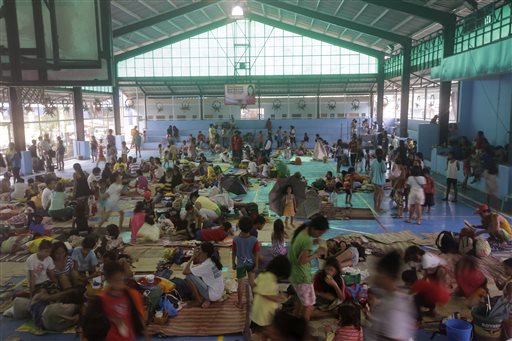Relief supplies rushed to ‘Ruby’ victims

Residents rest Tuesday, Dec. 9, 2014 in an evacuation center at suburban Quezon city northeast of Manila, Philippines after fleeing their homes in anticipation of typhoon Hagupit which was forecast to have hit Manila overnight after lashing central Philippines Sunday. AP
MANILA, Philippines–Authorities and aid agencies rushed relief supplies on Wednesday to hundreds of thousands of people displaced by Tropical Storm “Ruby” (international name: Hagupit), as survivors sifted through debris to rebuild their lives.
Military cargo planes will make eight deliveries to worst-hit Samar, while two Red Cross convoys will deliver thousands of food packs, water purifiers, blankets and hygiene kits, officials said.
“We are catching up on food delivery, especially in the far-flung areas, isolated areas in the mountains… We will strive to deliver to these areas today,” Social Welfare Secretary Corazon Soliman said in a televised briefing.
An estimated 390,000 people, mostly in Samar, need food and temporary shelter assistance, Philippine Red Cross Chair Richard Gordon told AFP.
Death toll
Ruby left more than two dozen people dead, the Red Cross said, after it slammed the Central Visayas region with 210-kilometer per hour winds over the weekend and brushed past the capital Manila.
Over a million fled to shelters ahead of the storm as authorities avoided a repeat of the devastation by Supertyphoon “Yolanda” (international name: Haiyan) last year, in which more than 7,350 were killed.
Interior Secretary Mar Roxas earlier said at least 200,000 people on Samar island needed help.
From Borongan, Eastern Samar, where he has been overseeing the government’s typhoon response, Roxas said the province, which bore the brunt of the typhoon’s wrath, was already “in stable condition and is now recovering in an ordinary hospital room.”
Out of ICU
“We have already taken the province out of the ICU (intensive care unit). What we need now is to sustain the recovery of the province,” he said.
Roxas said that airports and main roadways have been cleared for the relief operation.
A “human conveyor belt” was set up in one area to replace a damaged bridge that blocked aid delivery, he said.
After the wave of food aid, the Red Cross will deliver 10,000 galvanized iron roof sheets to those who lost their homes, he said.
Gordon said there would be “sporadic” increases in the death toll but the final count will be “nowhere near” Yolanda, the strongest storm to hit land ever recorded.
Hagupit totally damaged 6,200 houses and partially damaged 7,300 others, Roxas said.
Rebuilding
In Catbalogan, a major city in Western Samar, thousands have started to sift through debris under the hot sun to rebuild their homes, Mayor Stephany Uy-Tan told AFP.
“Daily existence here is a struggle for those who are affected,” she said.
But food relief from the national government had begun to arrive as roads were cleared of debris, she added.
Before Ruby struck, close to 21,000 people, or one-fourth of the city’s population, were moved to shelters in an unprecedented evacuation effort, she said.
“We had a long time to prepare, that’s very important,” Uy-Tan said.
Roxas said the residents and local officials of Eastern Samar should be credited for the minimal number of casualties.
“There’s really no magic in what happened here. We just followed the protocols. The people made this possible,” said Roxas, before he flew to Masbate to inspect the damage there on Wednesday.
Nearly 1.7 million people sheltered in evacuation centers as Ruby passed their areas, according to government figures, and aid agencies hailed the strategy as a template for coping with future disasters.
The International Labor Organization (ILO) said some 800,000 workers have been affected by Ruby.
The ILO said that Eastern Visayas accounted for the highest share of affected workers after Ruby and most of them are still recovering from income lost to Yolanda.
Over 350,000 workers, or roughly 20 percent of the total employed in Eastern Visayas, were affected by Ruby. Of these, more than half were in vulnerable forms of employment.
Seven other regions
Apart from the Eastern Visayas, initial ILO estimates covered seven other regions in the country battered by the typhoon—Central and Western Visayas, Caraga, Bicol, Calabarzon, Mimaropa and Metro Manila.
The ILO said it is ready to allocate $1.5 million and to support the Philippine government through emergency employment and sustainable livelihood.
The United Nations Population Fund on Wednesday said relief efforts in areas hit by Ruby must urgently focus on ensuring that reproductive health services will be easily accessible to pregnant women expected to deliver their babies soon to avert maternal and newborn deaths.–AFP with Marlon Ramos, Jocelyn R. Uy, Tina Santos and Christine Avendaño
RELATED STORIES
Pagasa monitoring LPA east of Mindanao
Relief, recovery work in full swing in Borongan














